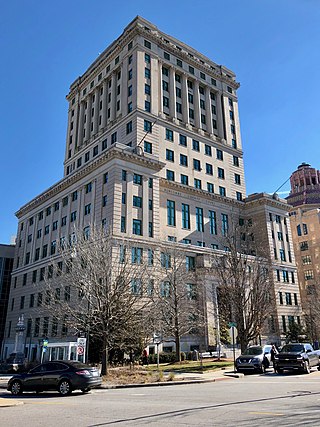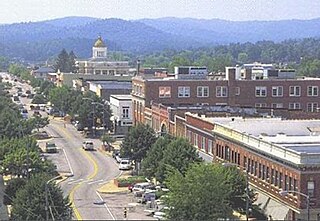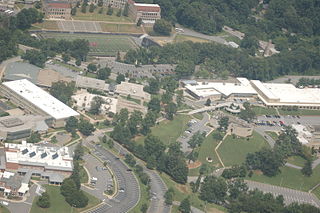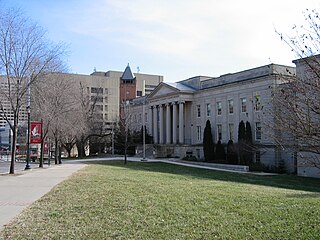
Buncombe County is a county located in the U.S. state of North Carolina. It is classified within Western North Carolina. The 2020 census reported the population was 269,452. Its county seat is Asheville. Buncombe County is part of the Asheville, NC Metropolitan Statistical Area.

Asheville is a city in, and the county seat of, Buncombe County, North Carolina. Located at the confluence of the French Broad and Swannanoa rivers, it is the largest city in Western North Carolina, and the state's 11th-most populous city. According to the 2020 census, the city's population was 94,589, up from 83,393 in the 2010 census. It is the principal city in the four-county Asheville metropolitan area, which had a population of 424,858 in 2010, and of 469,015 in 2020.

Hendersonville is a city in Henderson County, North Carolina, United States. It is 22 miles (35 km) south of Asheville and is the county seat of Henderson County. Like the county, the city is named for 19th-century North Carolina Supreme Court Chief Justice Leonard Henderson.

Asheville–Buncombe Technical Community College is a public community college in Asheville, North Carolina. Established in 1959, the college is one of the oldest in the North Carolina Community College System and serves Buncombe and Madison counties across five different campuses, although students from anywhere may enroll. As of the 2014–15 school year, the curriculum enrollment was 10,070 and continuing education enrollment was 14,053 students. As of 2019–20, the college is the seventh largest in the North Carolina system and the largest in Western North Carolina. A-B Tech offers more than 120 degrees, diplomas, and certificates.

The Montgomery County Circuit Courthouses are part of the Montgomery County Judicial Center located in downtown Rockville, Maryland. The Red Brick Courthouse, located at 29 Courthouse Square, houses the refurbished Grand Courtroom; the newer Circuit Court building, located at 50 Maryland Avenue, houses the remainder of the county's justice system.
Richard Sharp Smith was an English-born American architect, associated with Biltmore Estate and Asheville, North Carolina. Clay Griffith with the North Carolina State Historic Preservation Office says, "The influence of Richard Sharp Smith’s architecture in Asheville and western North Carolina during the first quarter of the twentieth century cannot be overstated." His vernacular style combines elements of Craftsman, Colonial Revival, English cottage, Shingle, and Tudor Revival architectural styles. He is associated with some of America's important architectural firms of the late 19th century—Richard Morris Hunt, Bradford Lee Gilbert, and Reid & Reid.

First Baptist Church is a historic Baptist church located at Asheville, Buncombe County, North Carolina. It was designed by architect Douglas Ellington and built in 1925–1927. It is a four-story, domed, polygonal brick building with Art Deco design influences. The front facade features a colossal hectastyle portico.

S & W Cafeteria is a historic S & W Cafeteria building located in the Downtown Asheville Historic District of Asheville, Buncombe County, North Carolina, USA. It was designed by the architect Douglas Ellington and built in 1929. It is a three-story, brick building in the Art Deco style. The front facade is sheathed in grey ashlar and features polychrome ornamentation and exotic stylistic motifs. In 1974, the S & W Cafeteria moved to the Asheville Mall.

Asheville Transfer and Storage Company Building is a historic warehouse located at Asheville, Buncombe County, North Carolina. It was built in 1929, and is a three-story, eight bay, Art Deco style reinforced concrete building. It features receding stepped brick panels on either side of the main entrance and a patterned brick parapet.

Young Men's Institute Building, also known as the YMI Building, is a historic meeting hall located at Asheville, Buncombe County, North Carolina. It was designed by architect Richard Sharp Smith and built in 1892–1893. It is a 2+1⁄2-story, pebbledash coated masonry building with brick, stone, and wood accents. From its early days, the YMI building has housed shops, residence rooms, meeting rooms, and a wide variety of functions serving the African American community of Asheville. The building was restored and reestablished as the YMI Cultural Center in 1980, and now hosts a variety of intercultural programs and events. It is located in the Downtown Asheville Historic District.

Schoenberger Hall was a historic residential building located at Asheville, Buncombe County, North Carolina. It was built in 1887, and was a 2 1/2-story, brick dwelling. It featured an Eastlake-detailed wraparound verandah and a slate-shingled mansard roof. The building was the former home of the Ravenscroft Associate Missions and Training School of the North Carolina Episcopal Diocese and the former residence of the Bishop of the Episcopal Diocese of Western North Carolina. The building has been demolished.

Buncombe County Courthouse is a historic courthouse building located at Asheville, Buncombe County, North Carolina. It was designed by architect Frank Pierce Milburn and built between 1924 and 1928. It is a 17-story, steel frame skyscraper sheathed in brick and ashlar veneer. It features complex setbacks and an extravagant overlay of Neo-Classical Revival ornament.

Oteen Veterans Administration Hospital Historic District is a historic hospital complex and national historic district located at Asheville, Buncombe County, North Carolina. The district encompasses 18 contributing buildings and 1 contributing structure associated with the Veterans' Administration hospital at Asheville. They were built between 1924 and 1940, and include white frame Colonial Revival and massive yellow stucco Georgian Revival structures. Notable buildings include the Administration Building (1928), Wards A and B (1925), Wards C and D (1930), Wards E and F (1932), Kitchen (1926) and Dining Hall (1930), Officers' Quarters (1927), and Nurses Dormitories. In 1967, a new Asheville, VA Medical Center complex was built adjacent to the original.

Ottari Sanitarium, also known as the Coburn Apartments, is a historic building complex located at 491 Kimberly Avenue in Asheville, Buncombe County, North Carolina. The original section was built in 1912, and now forms the east end of the building. It is a three-story, stuccoed brick building with a hipped roof. It was enlarged in 1923, with the addition of a three-story, 14 bay brick addition, connected to the original building by a two-story section. The building was converted to apartments in 1937.

Buncombe County Boys' Training School is a historic school building located near Asheville, Buncombe County, North Carolina. It was built in 1927–1928, and is a two-story, granite and brick main building in the Tudor Revival style. It consists of three principal sections with a two-story, rear ell containing the kitchen and other service areas. The school was permanently closed in 1945, and the building was reopened in 1947 as the new County Home for the Aged. Since 1983, the building has housed an Army National Guard training center. The building was renovated around 2006 and today, houses Buncombe County's Emergency Services and Operations Center It was listed on the National Register of Historic Places in 1997.

Blue Ridge Assembly Historic District is a national historic district located near Black Mountain, Buncombe County, North Carolina. The district encompasses 29 contributing buildings and 1 contributing object associated with the Blue Ridge Assembly, conference center of the Young Men's Christian Association. The main building is Eureka Hall designed by Louis E. Jallade. It was built in 1911–1912, and is a three-story, seven bay, frame building with a full-height octastyle portico. Also located on the large central courtyard are the Gymnasium, Asheville Hall (1926), Abbott Hall (1927), and College Hall. Other notable buildings include the Martha Washington Residence, Craft and Child Care Center, and 19 frame cottages (1913-1927). Black Mountain College was founded here in 1933 and operated on the site until 1941.
Downtown Asheville Historic District is a national historic district located at Asheville, Buncombe County, North Carolina. The district encompasses about 279 contributing buildings and one contributing object in the central business district of Asheville. It includes commercial, institutional, and residential buildings in a variety of popular architectural styles including Colonial Revival, Queen Anne, and Art Deco.

Morganton Downtown Historic District is a national historic district located at Morganton, Burke County, North Carolina. It encompasses 62 contributing buildings in the central business district of Morganton. It includes commercial, industrial, and governmental buildings built between about 1889 and 1940. It includes representative examples of Classical Revival, Art Deco, and Italianate style architecture. Notable buildings include the Old Burke County Courthouse, Morganton Post Office, and the Morganton Community House.
The following is a timeline of the history of the city of Asheville, North Carolina, USA.




















